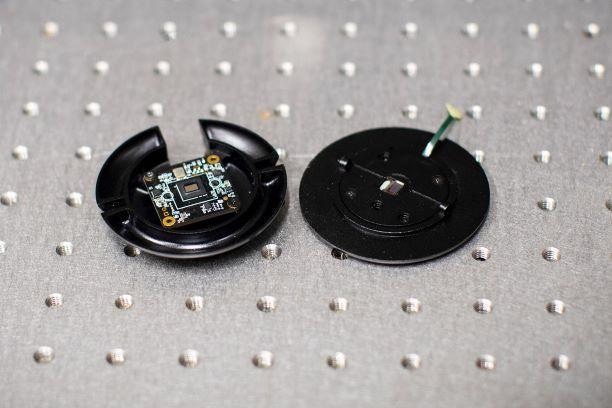Mar 10 2021
The University of Barcelona led an international team of researchers to develop the most inexpensive, smallest high resolution microscope so far, achieved by creating new nanoLEDs that serve as a light source and identify the microscope’s resolution without the need for lenses.
 Chipscope high-resolution microscope. Image Credit: University of Barcelona.
Chipscope high-resolution microscope. Image Credit: University of Barcelona.
The team launched a new start-up and began a new European project to launch this technology in the market.
The researchers have developed a new kind of super-resolution optical chip-sized microscope as part of the European project ChipScope. The microscope has been developed based on 200 nm nanoLEDs and could enable the observation of certain viruses and cellular processes in real time by overcoming the drawbacks of existing high resolution methods.
Although the existing prototype has been created at a cost of about 1,500 euros, it can come down to a few tens of euros when manufactured on a large scale. This is because it is based entirely on traditional microelectronic technologies.
ChipScope introduced a novel microscopy, contrary to the conventional one, where the resolution is dependent on the size of the light source rather than the detection system. In other words, rather than using only one source of light—for example, in traditional microscopes—the new technology involved the use of millions of miniature light sources.
The technological challenge was to develop 200 nm nanoLEDs forming an array. The sequential and independent activation enables us to determine the position of the observed object and to follow it real-time.
Ángel Diéguez, Project Coordinator and Lecturer, Department of Electronic and Biomedical Engineering, University of Barcelona
Diéguez is also a member of the Institute of Nanosciences and Nanotechnology of the University of Barcelona (IN2UB). This project demonstrated that the new microscopy works and provides a resolution dependent on the size of the LEDs used.
The researchers tested the new microscope with various samples, such as cellular images of idiopathic pulmonary fibrosis (IPF), a chronic lung pathology associated with age that affects humans and leads to half a million deaths per year.
The four-year long project has been financially supported with a fund worth 3.75 million euros within the European call Future and Emerging Technologies (FET Open).
Besides the University of Barcelona, other participants in the project are the Technical University of Braunschweig (Germany), University Rome Tor Vergata (Italy), the company Expert Ymaging (Barcelona), the Austrian Institute of Technology, the Medical University of Vienna, and the Swiss Foundation for Research in Microtechnology.
Exporting New Technology to the Market
As an extension of ChipScope, the Universit of Barcelona team is heading a new project called SMILE, where they “develop technology-based micro-lightening tools created in ChipScope. This is a step forward to bring this new technology to a broader market”, stated Daniel Prades, UB researcher and the coordinator of SMILE.
The aim is to create an array of microLEDs (measuring around 10 µm) to achieve a higher lighting intensity and which can be incorporated into standard optoelectronic instrumentation systems. This will enable a scalable lighting platform with regard to the number of pixels, speed and intensity and more flexibility than existing solutions.
Wgen the new tool is integrated with color conversion systems, it can function at different wavelengths and can find applications beyond microscopy, for example, in controls of chemical and biological reactions.
SMILE adapts the development to the market requirements by considering the participation of a group of end-users including research centers, small companies and multinationals from various branches that will be responsible for the final experimental tests in the areas of optogenetics, DNA chip manufacturing, high performance fluorimetry, holographic microscopy and photolithography.
The new project has been awarded financial support of almost 2 million euros in two years from the EIC Transition to Innovation call of the European FET-Proactive program (FETPROACT-EIC-06-2019), which is granted to potential technologies.
Thanks to these developments, the QubeDot GmbH start-up has been launched, in Braunschweig (Germany), with the goal of marketing the nanoLED array technology.
Lensless Highresolution Pocket Microscope_CHIPSCOPE - Beyond Smallness
Video Credit: University of Barcelona.